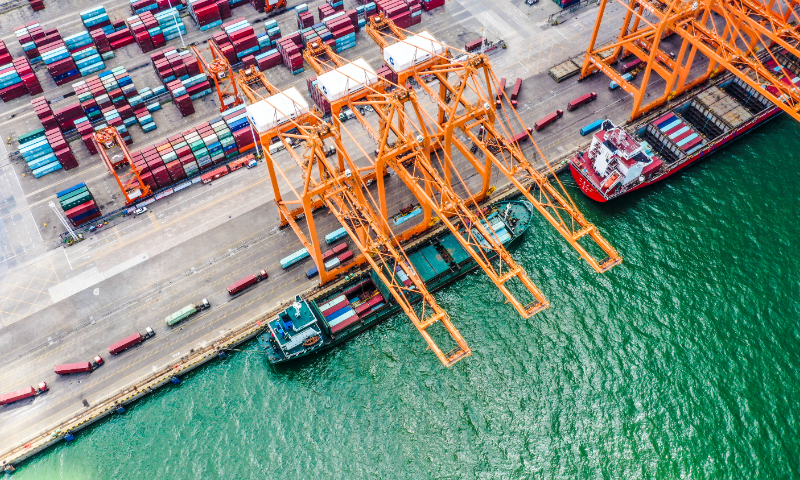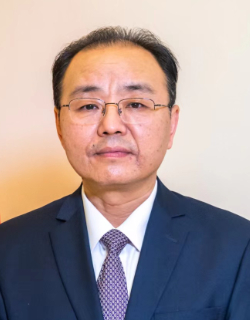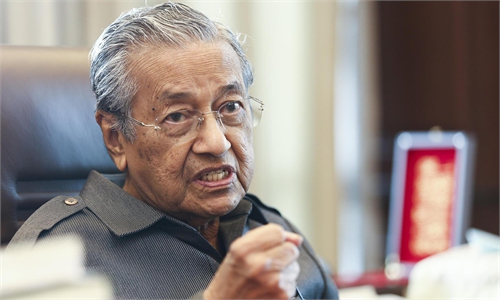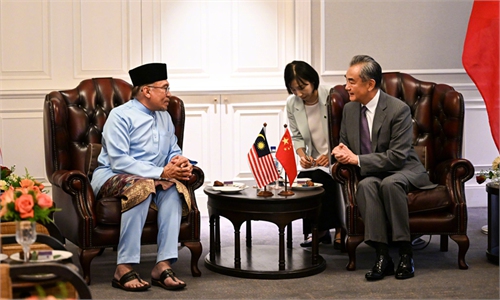China, Malaysia opens new chapter amid closer BRI cooperation and heightened exchanges, says Chinese envoy

An aerial photo of Qinzhou Port in South China's Guangxi Zhuang Autonomous Region File photo: VCG
Editor's Note:
The year 2023 marks the 10th anniversary of the establishment of a comprehensive strategic partnership between China and Malaysia, with next year witnessing the 50th anniversary of establishment of the diplomatic relations between the two countries. Earlier this year, Chinese President Xi Jinping and Malaysian Prime Minister Anwar Ibrahim reached a consensus on building a community of shared future for China and Malaysia, after Anwar's successful visit to China in late March. How have China and Malaysia maintained strong cooperation momentum? What practical benefits will the "Twin Parks" and the East Coast Rail Link project under the China-proposed Belt and Road Initiative (BRI) framework deliver to local people? What are the points of convergence between China's and Malaysia's development concepts? How should Southeast Asian countries respond to advocacy of the "China threat" theory by external forces? GT reporters Hu Yuwei, Li Xuanmin, Hao Shuangyan and Zhao Juecheng (GT) recently interviewed Chinese Ambassador to Malaysia Ouyang Yujing (Ouyang) in Kuala Lumpur to hear his insights on the current state of bilateral relations and cooperation.

Chinese Ambassador to Malaysia Ouyang Yujing Photo: Courtesy of Chinese Embassy in Malaysia
GT:How do you evaluate the current China-Malaysia relationship?
Ouyang: China and Malaysia are good neighbors with a thousand years of close ties, good friends who share a deep bond, and good partners focusing on win-win cooperation. The relationship between the two countries has always been at the forefront of China-ASEAN relations. It can be said that the China-Malaysia relationship is enduring and has broad prospects.
The first reason behind the booming relations is the clear navigation of high-level exchanges. As you know, in March of this year, President Xi Jinping and Prime Minister Anwar reached an important consensus on building a China-Malaysia community of shared future during Anwar's visit to China. This is a milestone event in the history of bilateral relations and has opened a new chapter in China-Malaysia relations.
The second reason is strong economic and trade cooperation. Last year, the bilateral trade volume between China and Malaysia reached $203.6 billion. China has been Malaysia's largest trading partner for 14 consecutive years. The cooperation in jointly building the BRI between China and Malaysia has steadily advanced, continuously delivering development dividends. During PM Anwar's visit to China, 300 Malaysian entrepreneurs were part of an accompanying delegation, and the two countries signed 19 memorandums of understanding with a total value of 170 billion Malaysian ringgit ($37 billion), setting a new record.
The third is heightened people-to-people exchanges. Cooperation in culture, tourism, education, science and technology, and other fields between China and Malaysia has yielded remarkable results. Taking tourism as an example. Since 2012, China has been Malaysia's largest source of tourists from outside ASEAN member countries, local spending generated by Chinese tourists accounting for 17.8 percent of Malaysia's total tourism revenue. With the COVID-19 pandemic now over, Chinese tourists have been flocking to Malaysia, and the recovery of the tourism industry is expected to provide strong impetus for Malaysia's economic growth.
GT: This year marks the 10th anniversary of the BRI. How do you evaluate cooperation between China and Malaysia under the BRI framework in the past decade? Looking ahead to the next decade, what are your expectations for high-quality BRI cooperation?
Ouyang: Malaysia is one of the earliest countries to support and participate in the BRI. With the care and support of the leaders of both countries, high-quality construction of the BRI between China and Malaysia has achieved fruitful results.
According to Malaysian data, China's direct investment in Malaysia reached $12.5 billion in 2022, accounting for one-third of Malaysia's foreign direct investment.
Flagship projects such as the "Two Countries, Twin Parks" and the East Coast Rail Link are progressing as planned, providing strong impetus for China-Malaysia economic and trade cooperation.
We hope both sides can upgrade cooperation in a more innovative, intelligent, digitized and sustainable way. It is believed that under the strategic guidance of the leaders of both countries, we will see more achievements and better benefits for the people of both countries.
GT: In January this year, Malaysian Prime Minister Anwar proposed a new concept called "Malaysia Madani (Civil Malaysia)." How do you view the integration between the concept of "a global community of shared future" and the concept of "Malaysia Madani"?
Ouyang: During Prime Minister Anwar's visit to China, he stated that the vision of building "a global community of shared future" is highly aligned with the "Malaysia Madani" initiative proposed by the Malaysian government.
The alignment between the two concepts is being both high-level and specific. First, we should follow the principle of "building a community of shared future between China and Malaysia," and promote our cooperation in various fields toward higher level of quality development. Second, we should deepen alignment of development strategies, promote deep integration of industrial chains, supply chains, data chains, and talent chains between the two countries. Third, we should continuously cultivate growth points for cooperation in areas such as electronics, digital economy, green development, new energy, high-end manufacturing, and modern agriculture, benefiting both countries and their people. Fourth, we should further promote people-to-people connectivity, strengthen cultural exchanges, and enhance mutual understanding between the people of the two countries, especially for younger generation.
GT: Malaysia Prime Minister Anwar inaugurated the first station for the East Coast Rail Link (ECRL) project in May. How do you evaluate the significance of the ECRL project for the local economic development, transportation connectivity, and people's well-being in Malaysia?
Ouyang: The ECRL project is the largest economic and trade cooperation project between China and Malaysia, as well as the largest single construction project undertaken by Chinese companies overseas. The ECRL spans a total length of 665 kilometers, crossing the Malay Peninsula and connecting the north and south of Malaysia.
I have visited the construction site of the ECRL project in Malaysia on several occasions. From a macro perspective, the ECRL project fully embodies the friendly and mutually beneficial cooperation between China and Malaysia. Specifically, the ECRL plays an important role in promoting local economic development, accelerating infrastructure connectivity, and improving people's well-being.
First, it promotes the overall economic development of Malaysia. According to research and statistics, during the construction phase alone, the ECRL will drive a 2.7 percent growth in the Malaysian economy and bring business opportunities to over 3,000 Malaysian companies.
Second, it promotes coordinated development between the East Coast and West Coast [of Malaysia], facilitating the transportation of people and goods.
Third it creates job opportunities and cultivates local talent. Currently, the ECRL project has employed over 21,549 workers, creating more than 5,000 jobs in Malaysia. In addition, the project has implemented a training program to train 5,000 rail workers in Malaysia. Currently, 1,052 people have completed their training under this program.
Fourth, it promotes people-to-people connectivity. For example, the Chinese project contractor has extended assistance to flood-affected areas in Malaysia, supported local orphanages, participated in community rebuilding, and strengthened people-to-people friendship between China and Malaysia.
GT: The South China Sea issue has always been an important topic between China and ASEAN member countries, but it is also a sensitive issue often used by external forces in attempts to fracture China's relations with Southeast Asian countries. You were incharge of China's border and maritime diplomacy at the Chinese Ministry of Foreign Affairs before serving as China's ambassador to Malaysia. What observations and feelings do you have regarding China's cooperation with regional countries in handling disputes and maintaining regional peace and stability?
Ouyang: The South China Sea is a common home for regional countries and should not become a hunting ground for external forces. Peace and stability in the South China Sea are in the interests of regional countries. Any attempt by any country to provoke relations between regional countries and create tension in the region through the South China Sea issue is futile.
I am pleased to see that, with the joint efforts of regional countries, the overall situation in the South China Sea remains stable. China and relevant parties have worked together to properly manage differences through dialogue and consultation, continue to fully and effectively implement the Declaration on the Conduct of Parties in the South China Sea, vigorously promote practical maritime cooperation, accelerate the consultations on the Code of Conduct in the South China Sea, and maintain peace and stability in the South China Sea region.
Since I became ambassador to Malaysia, my main perception of the South China Sea issue is that although China and Malaysia have different positions and views on the issue, we always prioritize bilateral relations and regional peace and stability, and seek to handle differences through dialogue and consultation in a friendly spirit. This fully demonstrates that as long as regional countries adhere to mutual trust and cooperation, they can take the initiative in handling disputes.
GT: In recent years, the US has been increasing its influence in Southeast Asia, intensifying its contacts with Southeast Asian countries in various channels. Some analysis suggests that there is a growing trend of competition and confrontation between the US and China in Southeast Asia. What is your view on this? Some Western officials, politicians, media, and think tanks have been propagating the "China threat" theory in Southeast Asia, trying to rally regional countries against China. What is your response to this?
Ouyang: President Xi Jinping pointed out that the vast expanse of the Earth is big enough to accommodate the respective development and common prosperity of China and the US.
Great power competition is not in line with the trend of the times. We always hope that China and the US can find the right way to coexist with mutual respect, peaceful coexistence, and win-win cooperation, which is also of great significance to Southeast Asia.
There are some voices that agitate the "China threat" theory, attempting to sow discord between China and regional countries. Those with insight can readily see through this blatant Cold War mentality.
China and Malaysia both belong to the Asian civilization, and they are both developing countries, important emerging economies, and progressive forces on the international stage. They are beneficiaries, contributors, and defenders of economic globalization and multilateralism.
We are ready to work with Malaysia to promote Asian civilization, uphold strategic autonomy, strengthen strategic cooperation, support ASEAN's central role, firmly resist any Cold War mentality and bloc confrontation, and adhere to open regionalism.



